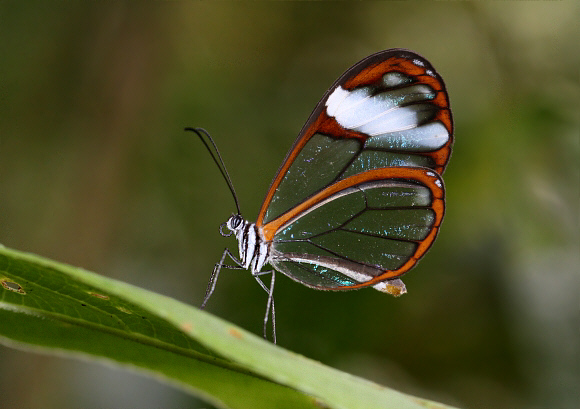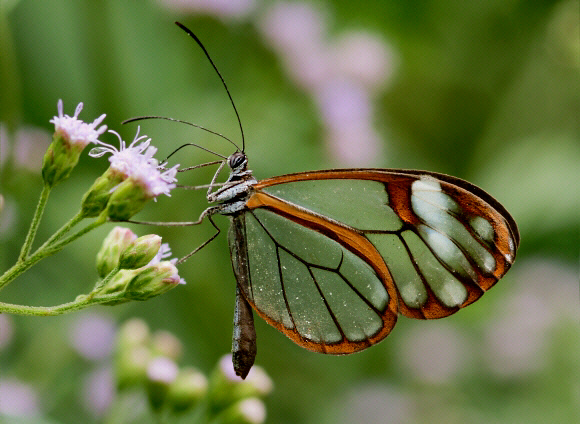
Introduction
The Ithomiini comprises of 376 known species, although it is likely that at least another 30 will be discovered in the near future. All are confined to the neotropical region. Ithomiines are unpalatable to birds, and are consequently mimicked in appearance by many other species. These include other unpalatable species ( Müllerian mimics ), not only from the Ithomiinae but also from several other butterfly families. There are also a large number of edible species ( Batesian mimics ) which have evolved similar patterns. Birds have the ability to memorise butterfly patterns and so learn to avoid eating noxious species, but are also fooled into ignoring similarly marked edible species.
Ithomiines are characterised by having small eyes, slender abdomens and long drooping antennae that lack distinct clubs. Males have a plume of long androconial scales or ‘hair pencils’ on the costa of their hindwings. These are hidden from view when the butterflies are at rest, but are displayed when the wings are held open during courtship. Other Ithomiine characteristics include a very slow and deep wing beat, and a preference for inhabiting the darkest recesses of the forest understorey.
There are basically 2 types of Ithomiine. The first type are the black and orange-banded ‘tigers’, many of which are mimicked by other species due to their unpalatability to birds. The second type are the ‘glasswings’, recognised by their transparent or translucent wings, prominent veins, and orange wing margins. Many genera contain examples of both of these types, and in some cases an individual species may produce adults of both forms according to location.
There are 30 known Greta species, including 8 which have only recently been discovered and have not yet been assigned scientific names. The species are variously distributed from Mexico to Bolivia. All Greta species are of the ‘glasswing’ type. They are characterised by having distinctive venation, long dark antennae, and scalloped submarginal borders. The clear areas of the wings are untinted in most species, and have a pattern of pure white suffused post-discal and submarginal spots.
Greta andromica is distributed from Mexico to Peru. There are 7 named subspecies.
Habitats
This species inhabits cloudforest at altitudes between about 600-2200m. The adults are often seen along roadsides, nectaring at Eupatorium on cloudy mornings.
Lifecycle
The eggs are white, and are laid singly on the foodplant Cestrum ( Solanaceae ). The caterpillar is translucent whitish-green with a pair of dark yellow stripes running along the length of the back. The chrysalis is chrome-silver, giving the impression of a large rain drop.
Adult behaviour
Males are usually encountered in the company of other Ithomiines, nectaring at Eupatorium flowers, or imbibing fluids exuding from the stems of Heliotropium, from which they sequester pyrrolizidine alkaloids. These are processed within their bodies to produce pheromones which are disseminated from androconial scales in the form of ‘hair pencils’ on the leading edge of the hindwings. They can sometimes be seen slowly fanning their wings to disperse the pheromones.

